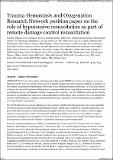Trauma Hemostasis and Oxygenation Research Network position paper on the role of hypotensive resuscitation as part of remote damage control resuscitation
Abstract
The Trauma Hemostasis and Oxygenation Research (THOR) Network has developed a consensus statement on the role of permissive hypotension in remote damage control resuscitation (RDCR). A summary of the evidence on permissive hypotension follows the THOR Network position on the topic. In RDCR, the burden of time in the care of the patients suffering from noncompressible hemorrhage affects outcomes. Despite the lack of published evidence, and based on clinical experience and expertise, it is the THOR Network’s opinion that the increase in prehospital time leads to an increased burden of shock, which poses a greater risk to the patient than the risk of rebleeding due to slightly increased blood pressure, especially when blood products are available as part of prehospital resuscitation. The THOR Network’s consensus statement is, “In a casualty with life-threatening hemorrhage, shock should be reversed as soon as possible using a blood-based HR fluid. Whole blood is preferred to blood components. As a part of this HR, the initial systolic blood pressure target should be 100 mm Hg. In RDCR, it is vital for higher echelon care providers to receive a casualty with sufficient physiologic reserve to survive definitive surgical hemostasis and aggressive resuscitation. The combined use of blood-based resuscitation and limiting systolic blood pressure is believed to be effective in promoting hemostasis and reversing shock”
Citation
Woolley , T , Thompson , P , Kirkman , E , Reed , R , Ausset , S , Beckett , A , Bjerkvig , C , Cap , A , Coats , T , Cohen , M , Despasquale , M , Dorlac , W , Doughty , H , Dutton , R , Eastridge , B , Glassberg , E , Hudson , A , Jenkins , D , Keenan , S , Martinaud , C , Miles , E , Moore , E , Nordmann , G , Prat , N , Rappold , J , Reade , M C , Rees , P , Rickard , R , Schreiber , M , Shackelford , S , Skogran Eliassen , H , Smith , J , Smith , M , Spinella , P , Strandenes , G , Ward , K , Watts , S , White , N & Williams , S 2018 , ' Trauma Hemostasis and Oxygenation Research Network position paper on the role of hypotensive resuscitation as part of remote damage control resuscitation ' , The Journal of Trauma Acute Care Surgery , vol. 84 , no. 6S , pp. S3-S13 . https://doi.org/10.1097/TA.0000000000001856
Publication
The Journal of Trauma Acute Care Surgery
Status
Peer reviewed
ISSN
2163-0755Type
Journal article
Collections
Items in the St Andrews Research Repository are protected by copyright, with all rights reserved, unless otherwise indicated.

